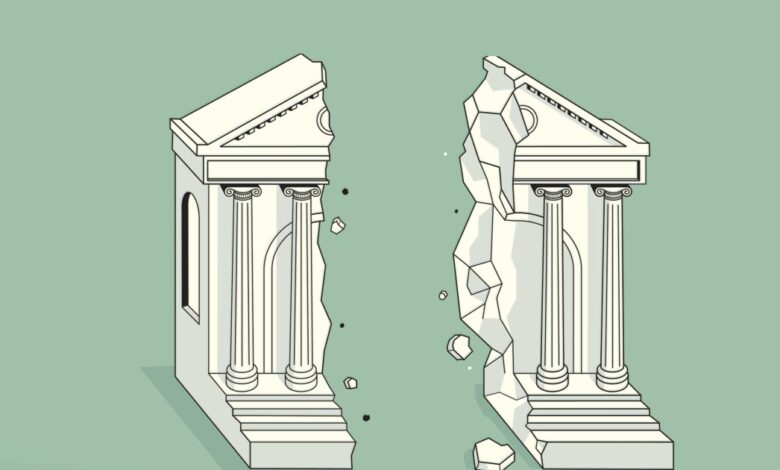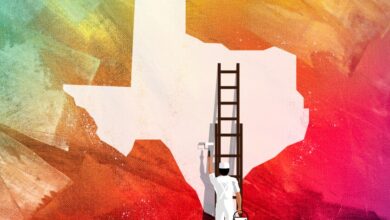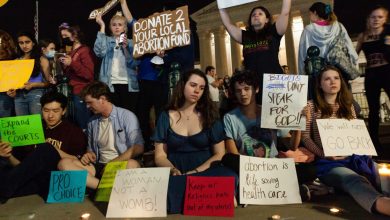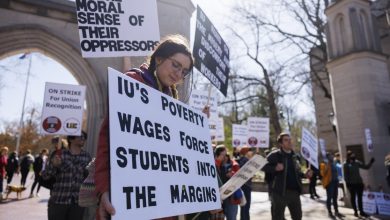In an Era of College Mergers, Why Is One Large Public University Splitting?

He felt the capital of “the Crossroads of America” deserved the research dollars, the brainpower, the talent pipeline, and the prestige that come with a state flagship. “If we truly believe that Indianapolis is the great city destined for much greater years ahead,” he insisted, it “must have at its heart a great university.”
Lugar got his wish, in a way. Within two years, the state knit together branch campuses and professional schools of the two existing universities into Indiana University-Purdue University Indianapolis. Lugar would go on to a long and distinguished career in the U.S. Senate before his death in 2019. Metropolitan Indianapolis would grow from fewer than one million residents in 1968 to nearly two million today, growing steadily through 2020 even as some other Midwestern cities shrank.
But the new university was a bit ungainly from birth. Many informally shortened its mouthful acronym, IUPUI, into the cartoonish “Ooee-pooey.” It would grow from an urban commuter school into a research university with a total enrollment of nearly 25,000 students but would never equal the enrollment or research level of its constituent institutions, and it would never quite cohere as a single entity, as campus operations and most of the academic programs were managed by Indiana University, and a handful of schools were still loosely affiliated with Purdue.
While the new university served an important function for students in Indianapolis, it was less important to campus leaders in Bloomington and West Lafayette. IUPUI was “a confederation of two schools, but not the primary focus of either school,” says David L. Johnson, president of the Central Indiana Corporate Partnership, an organization of 65 corporate executives, foundation heads, and university leaders in the state.
Now, after 52 years, IU and Purdue are chopping the Indianapolis campus into two pieces. Starting in the fall of 2024, the Purdue schools will become an official branch campus of Purdue, and the remainder of IUPUI will become Indiana University at Indianapolis, a stand-alone institution. According to a statement released by Indiana University, the split will lead to “a more energized role for each university and the production of more graduates ready to participate in the modern economy.”
So, at a time when many states and public-college systems are retrenching and merging institutions to deal with tight budgets and dwindling students, Indiana is making a different bet. On one hand, the dissolution of IUPUI illustrates the particular limits of its inorganic hybrid. On the other, it speaks to larger forces, like the surging ascendency of many state flagships in a hyper-competitive market, where branding, distinction, and a wealth of resources compound each other as advantages.
In the end, Lugar’s city will end up with two major research universities operating within its limits.
It still retained key divisions based on its parental DNA, however, and operates in a bifurcated fashion to this day. The two academic units originally most closely associated with West Lafayette — the Purdue School of Engineering and Technology and the Purdue College of Science — remain so and issue Purdue diplomas to majors. The rest of the university provides a general-education curriculum for all students and specializes in health care, business, liberal arts, and other disciplines, and issues diplomas from Indiana. There has been little overlap between what the two universities brought to the marriage.
Rob Elliott knows IUPUI well. He earned his bachelor’s degree from the Purdue side and his master’s from the Indiana side of IUPUI before earning his Ed.D. in instructional systems technology from Indiana’s Bloomington campus and returning to IUPUI as a teaching professor of computer and information technology in the School of Engineering and Technology. As a student and a faculty member, he’s lived with its strange, divided nature. “It’s kind of like the little campus that could,” he says. “Administratively, IUPUI was a little awkward, but we’ve made it work.”
But, he acknowledges and others agree, the university baffled outsiders. It was both Indiana and Purdue and not exactly either. Elliott’s paychecks come from Indiana, but his students’ diplomas come from Purdue. “It felt like every conversation we had,” he says, “we had to start out by explaining IUPUI.”
While combining institutions can create complications, it also often provides benefits, such as cost savings. But such partnerships “ultimately are kind of unstable because of the asymmetry involved,” says Peter Ewell, a senior consultant at the National Center for Higher Education Management Systems, a nonprofit organization that works with colleges. Indiana University runs IUPUI’s campus, but Purdue’s national profile has risen in recent years, and its “brand identity is sort of buried in IUPUI,” Ewell says, adding that the West Lafayette institution may benefit most from a new stand-alone presence in Indianapolis.
Indiana University and Purdue have grown over the past half century, but most of that growth has taken place at the main campuses, not in Indianapolis. Purdue has seen eight years of record enrollments, with nearly 51,000 students total. IU’s Bloomington campus welcomed 9,736 new undergrads this fall, also a record. IUPUI’s undergraduate enrollment has fallen from 21,777 in the fall of 2014 to 17,278 in 2022, a decline of nearly 21 percent.
“So we’ve ended up with, on the one hand, this large physical footprint of IU and presence of IU and Purdue,” Johnson says, “but not necessarily the primary focus and priority of either university or either university president until now.”
Among those who would make Indianapolis a priority was Mitch Daniels, a former Lugar staffer who was elected governor of Indiana in 2004, and in 2013 became president of Purdue. While in the statehouse, Daniels viewed IUPUI as a “less than optimal” compromise between Indiana University and Purdue, but not the genuine research-university presence the city needed to grow. “As I got a closer look, having changed jobs,” he says in an interview, “I became a little more confirmed in that outlook.”
Daniels will retire at the end of the year, and the dissolution of IUPUI caps a series of ambitious moves he’s made on behalf of Purdue, including acquiring the former for-profit education company Kaplan University and rebranding it as Purdue University Global to give the institution a foothold in the world of scaled-up online education.
The leadership of Indiana University is eager to make the split, too. Soon after Pamela S. Whitten took over as president of the university in the summer of 2021, she and Daniels began discussing “what can we do to really elevate and enhance IUPUI,” she says. “That was the initial conversation.” Her own presidential listening tour of her institution and the state had convinced her that, in Indianapolis, there was “a real hunger to increase the presence of IU as a research institution and to grow science and technology in Indiana.”
The details of how IU and Purdue will split and reconstitute themselves as independent institutions will be worked out over the next year, with input from some of those most affected by the changes. “I always wish the faculty were consulted earlier in these matters, but it does look like the faculty will be involved a lot in the task forces that have been set up” to guide the transition, says Goff. “The president has been clear that our IU is going to look like what we want it to look like.”
Even though students at the new Purdue University campus in Indianapolis will continue to take some classes at Indiana University at Indianapolis and faculty members will still use IU libraries, professors have built collegial relationships with soon-to-be-former faculty peers. “We’ll still be able to collaborate,” Goff says, “but it will make it harder.”
There are also more than half a century of institutional ties to unwind and restore. For example, the Purdue programs in Indianapolis have operated independently of their counterparts in West Lafayette, and “after 52 years, we kind of branched off,” says Elliott, of IUPUI. Courses that served the Indianapolis campus and the types of students that came to IUPUI may not fit as well with programs on the home campuses.
The faculty will also need to be better integrated. Purdue has already set up a grant program to encourage professors from Indianapolis and West Lafayette to partner on projects together “to facilitate making some of those connections in a very tangible way,” Elliott adds, “which I think was a very smart move right off the bat.”
The benefits for Indianapolis seem more clear-cut. Two autonomous research universities’ taking the place of one partnership will “untether the beast,” says Chris Lowery, head of the Indiana Commission for Higher Education, and allow “those institutions to really double down and focus on the things at which they’re really good.”
Johnson, from the Central Indiana Corporate Partnership, sees the split as a possible answer to a missing piece of the puzzle for Indianapolis’s future. When Amazon conducted a nationwide search for a location for a second headquarters, Indianapolis was one of hundreds of cities to submit proposals, and it made it into the top 20 finalists. While it wasn’t chosen, Johnson found the results revealing. Of the top 20 finalist cities, 19 were home to universities classified R1 in the Carnegie rankings, the uppermost level of university research, including other medium-sized cities such as Columbus, Ohio; Nashville; and Raleigh, N.C. The only city that didn’t was Indianapolis. The lesson: When it comes to being part of the innovation economy, Indianapolis is in the game, “but we’re barely in it,” Johnson says. “The lack of a truly focused R1 university is probably our greatest missing piece of necessary infrastructure.” Such an institution — or more than one — with connections to the upper levels of research, technology, and industry would help attract and retain companies and build a talent pipeline, among other benefits.
The results from the split for students could be more mixed. Since the two Purdue schools in Indianapolis will now be fully integrated units of the main Purdue campus, it will be much easier for Purdue students studying in West Lafayette to take on internships or co-ops in Indianapolis without having to transfer between institutions or commute 65 miles, as they would have for the last 52 years. But students in Indianapolis who want to study engineering or one of the other subjects taught at the two Purdue schools that are currently part of IUPUI, which admits 84 percent of applicants, will now have to apply to Purdue, which admits about 69 percent of applicants (both cost about $10,000 in tuition per year for in-state students).
It’s also unclear if students from the soon-to-be two Indianapolis campuses will succeed at levels that are more similar to those on each institution’s home campus. According to federal data, Purdue’s West Lafayette campus retained 91 percent of full-time freshmen who began their studies in 2020 and IU at Bloomington retained 90 percent. IUPUI retained 69 percent. The six-year graduation rate for the 2015 cohort of undergraduates is 90 percent at IU and 83 percent at Purdue. At IUPUI it’s 57 percent. The latter institution serves a larger share of lower-income students than both IU and Purdue combined, with 41 percent of full-time undergraduates eligible for Pell Grants compared with 19 percent at IU and 14 at Purdue.
There may be other wrinkles to the dissolution for students. Purdue students will still be able to take some IU classes, but IU will no longer run joint operations. Will Purdue students have IU logins and emails? How will they pay their tuition? “These are the questions that we’re just starting to ask and kind of need to,” says Elliott. “How is this going to impact the students who are used to IUPUI now, and how are we going to explain it to students who start attending after … what’s the opposite of merger?”
Elliott is not quite ready to move on yet. As a faculty member, and an alumnus, he hopes that IUPUI doesn’t dissolve unmourned. The university may not have lived up to all expectations, “but I don’t think that that’s anything necessarily that we did wrong,” he says. “We also need to appreciate what we’ve done for the last 52 years, and I’m not sure there’s been enough time spent celebrating the successes.”
Source link






